Introduction
In an age where efficiency reigns supreme, mainframe automation emerges as a transformative force, redefining how organizations operate. As companies grapple with the complexities of outdated systems and the demands of a fast-paced market, the strategic implementation of automation technologies becomes essential. From robotic process automation (RPA) to artificial intelligence (AI), the tools available today not only streamline operations but also enhance accuracy and scalability.
However, the path to successful automation is fraught with challenges, including resistance to change and integration complexities. This article delves into the myriad benefits of mainframe automation, explores the key technologies driving this evolution, addresses the hurdles organizations face during implementation, and highlights future trends that promise to shape the landscape. By understanding and navigating these elements, businesses can unlock new levels of efficiency and innovation, positioning themselves for sustained success in an increasingly competitive environment.
Defining Automation in Mainframe Systems
Automation in mainframe systems represents a strategic shift toward executing tasks with minimal human oversight, significantly enhancing operational efficiency. A mid-sized company faced challenges such as:
- Manual information entry errors
- Slow software testing
- Difficulties integrating outdated systems without APIs
By streamlining repetitive tasks such as information entry, report creation, and system oversight through graphical user interface processes, the company attained significant enhancements. They reported:
- A 70% reduction in entry mistakes
- A 50% acceleration in software testing
- An 80% improvement in workflow efficiency, achieving a return on investment within just six months.
In 2024, organizations implementing robotic process automation (RPA) in their mainframe environments have seen a 30% reduction in processing time for routine tasks. Tools like EMMA RPA and Microsoft Power Automate specifically address these challenges by streamlining workflows and minimizing errors, which enhances employee morale.
As Craig Stedman, an industry editor, points out, ‘Business users typically engage in the process to ensure that information meets their needs and to assist in establishing internal standards and usage policies as part of governance programs.’ This collaborative method promotes a culture of information governance and improves overall system effectiveness. Companies that prioritize data governance and quality in their strategies are better positioned to adapt to evolving business needs, ultimately driving greater business value.
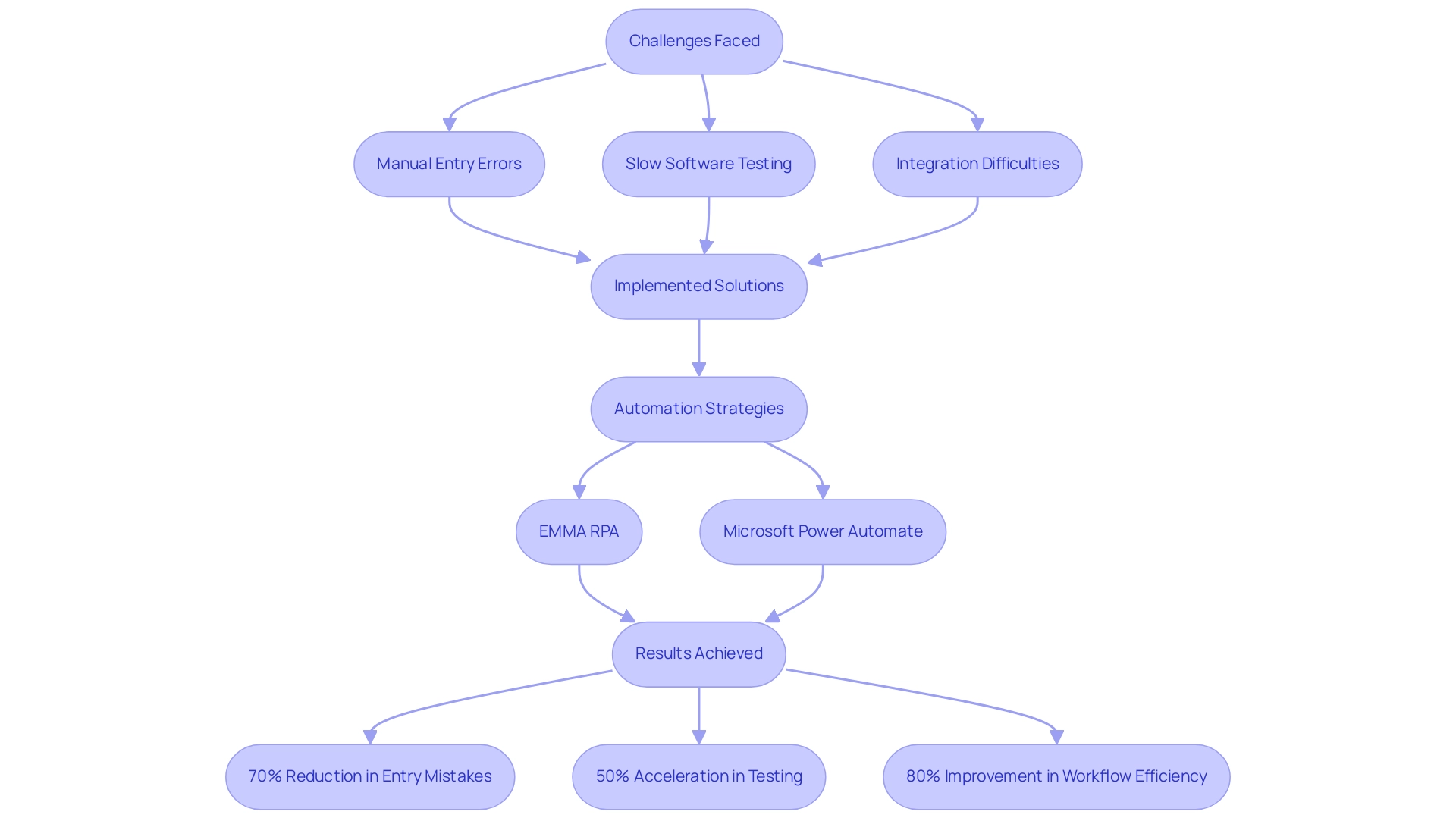
The Importance and Benefits of Mainframe Automation
The importance of mainframe optimization, especially via Robotic Process Automation (RPA), is crucial for organizations looking to improve efficiency. By embracing automation, businesses can unlock a range of substantial benefits:
-
Cost Reduction: Automating processes significantly decreases reliance on manual labor, leading to considerable savings in operational expenditures. In fact, a recent study indicates that organizations adopting mainframe technology can expect cost savings of up to 30% by 2024. For instance, companies utilizing BlueprintCPQ’s cloud-based solutions have reported notable reductions in IT overhead, with some seeing savings of over $100,000 annually.
-
Enhanced Accuracy: Automation reduces human error, ensuring consistent and precise information processing. A case study involving a mid-sized healthcare company demonstrated that implementing GUI automation reduced data entry errors by 70%, showcasing the importance of accuracy in maintaining trust in operational data and decision-making.
-
Increased Speed: Tasks that previously required hours or even days can now be executed within minutes, granting entities the agility to adapt swiftly to market demands. The same case study highlighted that automated software testing processes were accelerated by 50%, significantly improving workflow efficiency.
-
Improved Compliance: Automated systems assist entities in adhering to regulatory standards, thereby mitigating the risks associated with non-compliance, which can be costly and damaging to reputation.
-
Scalability: With mechanization, businesses can effortlessly scale operations to accommodate growth without necessitating significant additional resources, ensuring they stay ahead of evolving market dynamics.
Before implementing RPA, many companies faced significant challenges, including high manual labor costs, frequent errors, and slow response times. The current landscape underscores the necessity of continuous innovation in CPQ solutions to align with changing customer preferences. Industry insights from Interactive Selling Systems (ISS), a pioneer in CPQ technology since 1983, emphasize that ‘streamlining is not just an enhancement; it is a crucial element for succeeding in today’s competitive environment.’ The strategic implementation of RPA and tailored AI solutions in mainframe systems positions organizations to not only improve efficiency and reduce costs but also to drive forward-thinking innovations.
A compelling case study of BlueprintCPQ illustrates these benefits effectively. By leveraging their cloud-based CPQ solution, a manufacturing client reported a 25% reduction in pricing errors, leading to faster sales cycles and increased customer satisfaction. This example emphasizes how mechanization not only lowers expenses but also improves overall business performance, reinforcing the essential role that RPA and Business Intelligence play in informed decision-making and efficiency.
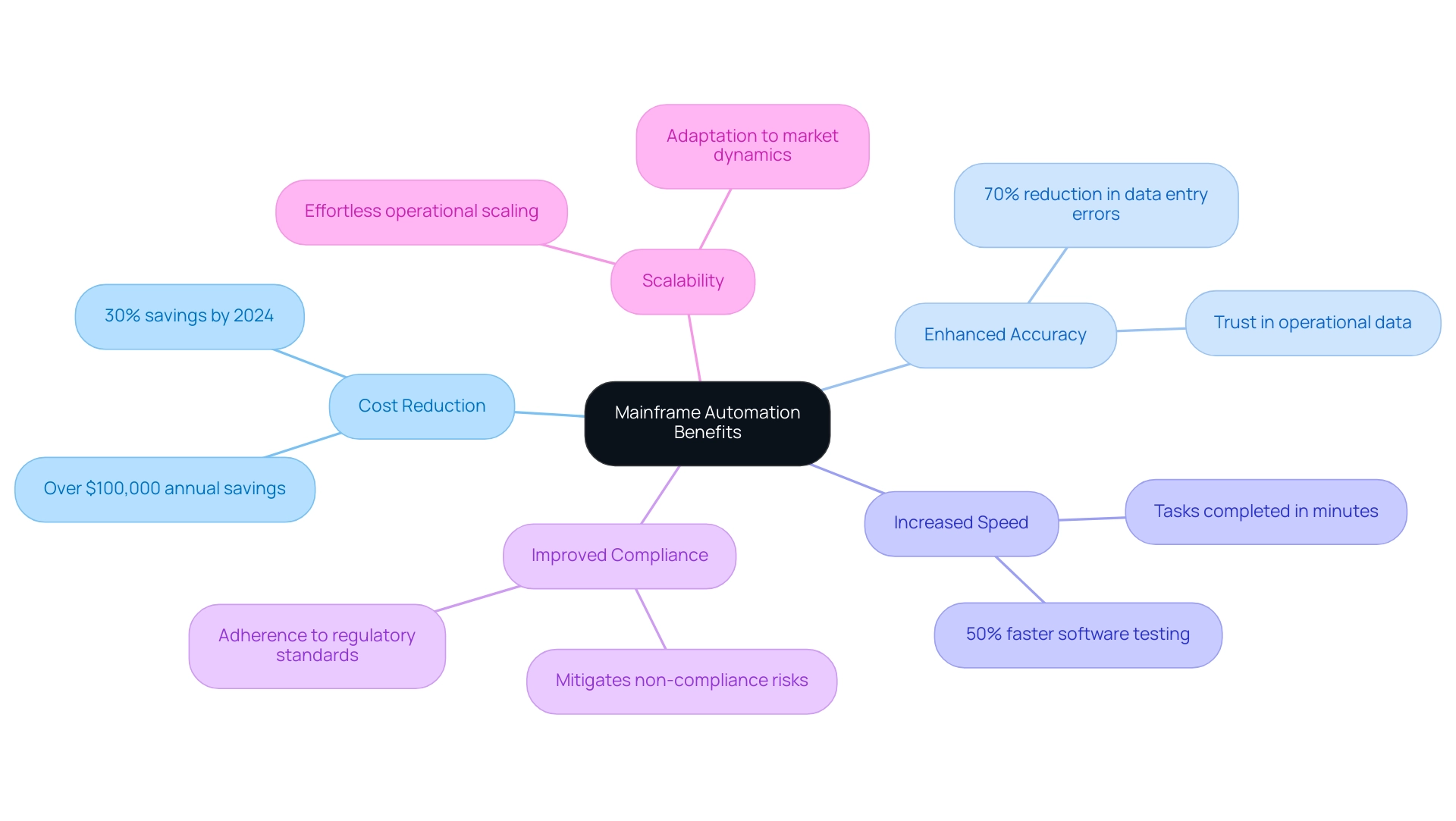
Key Technologies in Mainframe Automation
The landscape of automation in mainframe systems is powered by several key technologies that are essential for optimizing operations:
-
Robotic Process Automation (RPA): RPA tools, such as EMMA RPA and Microsoft Power Automate, excel at automating repetitive tasks by mimicking human actions. These innovative solutions enhance efficiency, improve employee morale, and address challenges such as task repetition fatigue and staffing shortages. EMMA RPA, for example, transforms processes by offering a user-friendly interface that facilitates seamless digitalization, enabling organizations to minimize errors and enhance productivity. Recent statistics indicate that the market share of RPA tools is expected to reach 30% by 2024, showcasing their growing importance in operational efficiency. This capability not only accelerates processing times but also minimizes the potential for errors, leading to enhanced accuracy in operations.
-
Artificial Intelligence (AI): AI technologies significantly enhance automation efficiency by allowing systems to learn from past information and make informed decisions. Our customized AI solutions, including Small Language Models and GenAI Workshops, enable companies to tackle challenges such as inadequate master information quality and perceived AI complexities. Small Language Models offer efficient data analysis while ensuring enhanced privacy, and GenAI Workshops provide hands-on training for custom GPT creation. According to industry experts, AI’s role in mainframe management is crucial for organizations aiming to streamline processes and react more dynamically to changing operational demands. Significantly, Thomas Rutter highlights that “AI can change conventional methods, enabling smarter, more adaptable systems.”
-
Mainframe Automation Tools: Tailored software solutions specifically designed for mainframe environments facilitate the automation of critical tasks such as job scheduling, resource management, and system monitoring. Recent developments in these tools have introduced enhanced features that improve user experience and operational control. By utilizing these advanced solutions, enterprises can ensure that their mainframe operations run smoothly and efficiently.
-
Cloud Integration: The integration of mainframe systems with cloud services offers remarkable flexibility and scalability. This synergy enables the creation of more dynamic solutions that can adjust to the changing requirements of the business environment. By utilizing cloud capabilities, entities can improve their efficiency strategies, ensuring they stay competitive in a swiftly evolving environment.
By utilizing these advanced technologies and remaining updated on the latest trends, entities can create a thorough system that not only improves their mainframe operations but also positions them for increased efficiency and competitiveness in the market.
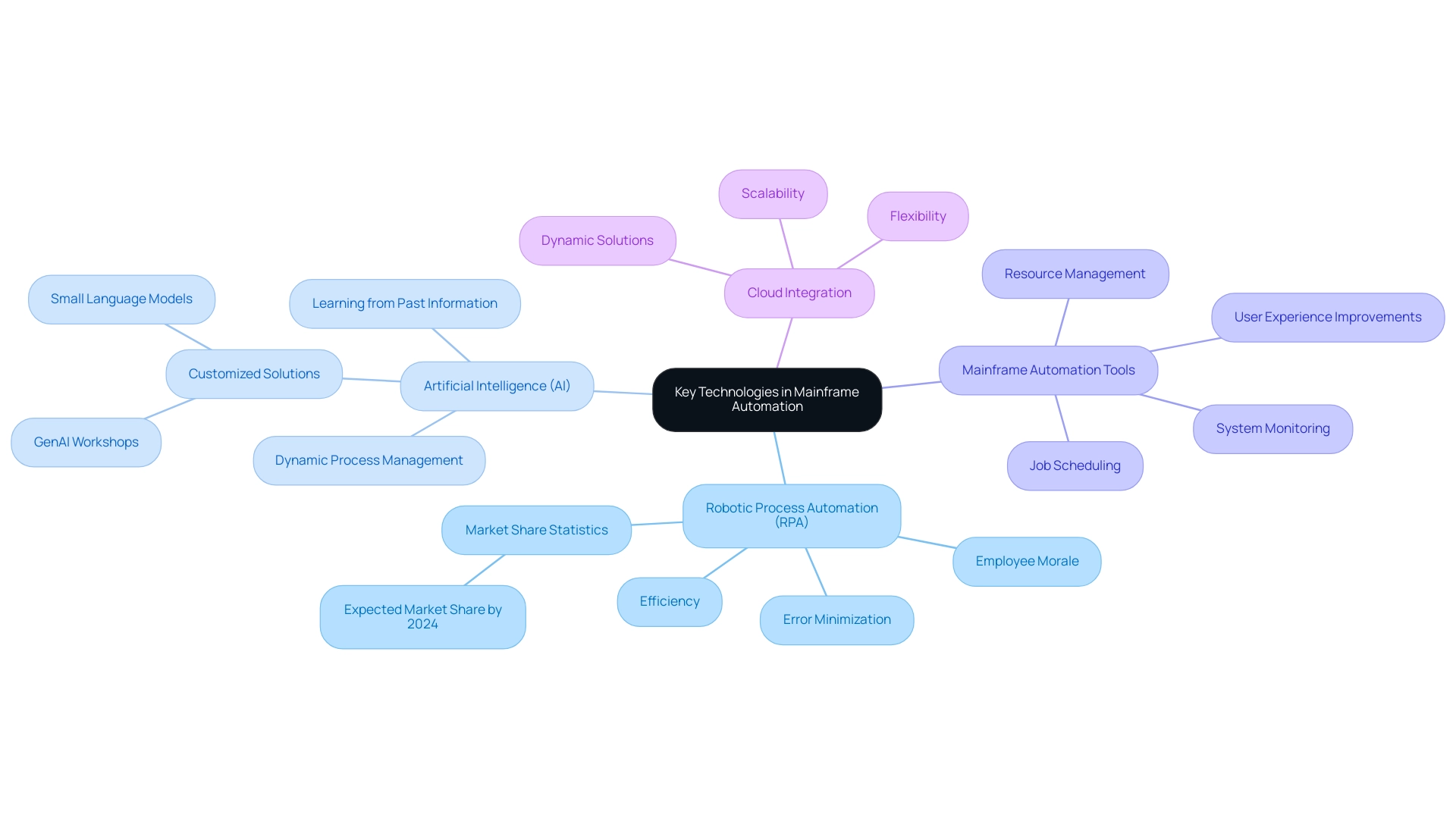
Challenges in Implementing Mainframe Automation
Despite the clear advantages of mainframe automation, organizations often face a series of challenges during implementation that must be effectively managed:
-
Resistance to Change: Employee apprehension about adopting new technologies can pose a significant barrier, with around 60% of employees expressing concerns regarding mechanization in their workplaces as of 2024. Implementing robust change management strategies is crucial to fostering a culture of resilience and encouraging acceptance among staff. For example, one organization successfully navigated this challenge by actively involving employees in the process, ultimately reducing resistance by 40%.
-
Integration Complexities: The technical challenges of incorporating automated tools with existing mainframe systems require careful planning and comprehensive testing. This ensures compatibility with legacy frameworks and minimizes disruptions. Industry experts indicate that nearly 70% of mechanization initiatives fail due to integration issues, underscoring the necessity for meticulous preparation.
-
Skill Gaps: The swift advancement of technological innovations often leaves organizations facing skill shortages. Investing in focused training and development programs is essential to prepare teams with the necessary skills to manage and utilize new technological solutions effectively. Automation specialist Dr. Linda Carter emphasizes, “Organizations must prioritize upskilling their workforce to keep pace with technological advancements.”
-
Cost Considerations: While mechanization can yield significant long-term savings, the initial costs can be substantial. Organizations should conduct a thorough evaluation of the return on investment for mechanization initiatives, carefully balancing upfront expenses against anticipated future benefits. This evaluation should also consider the potential for RPA to streamline workflows, reduce errors, and ultimately enhance operational efficiency.
-
Role of Business Intelligence: In addition to RPA, leveraging Business Intelligence tools is essential for informed decision-making. These tools can convert raw data into actionable insights, assisting organizations in evaluating the effectiveness of their initiatives and making strategic adjustments as necessary.
Addressing these challenges proactively is essential for paving the way for successful mainframe process initiatives. As mentioned by Jason Bloomberg, with legislative frameworks like the Digital Resilience Act (DORA) influencing mandates, operations teams must rise to the challenge and cultivate resilience in their processes, leveraging RPA and tailored AI solutions to enhance efficiency and combat workplace challenges.
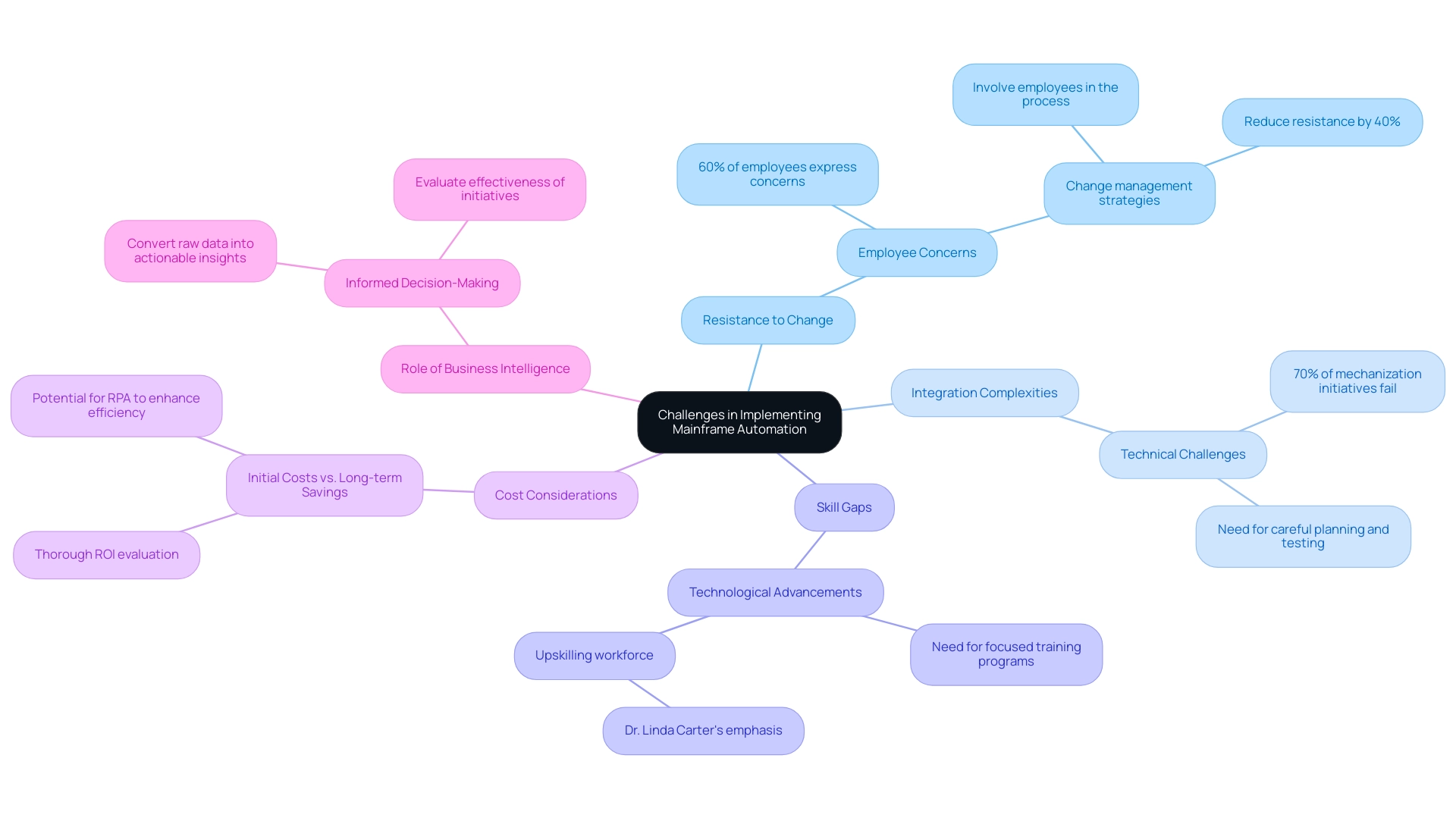
Future Trends in Mainframe Automation
As technology rapidly advances, several trends are set to shape the future of mainframe automation, providing entities new opportunities for efficiency and growth:
-
Increased AI Integration: The adoption of AI in automation tools is poised to revolutionize decision-making processes, enabling the development of smarter, more adaptive systems. Recent statistics reveal that IBM’s self-service digital assistant handled 5.4 million interactions across 77 countries, showcasing the impact of AI in enhancing operational efficiency. Mario Schlener, a leader in global risk technology, stresses this transition:
As enterprises enhance the use of AI within their firms, it is crucial to have trust in the information and models that inform their analyses and decisions.
Such confidence is essential as entities adopt AI-driven processes and address issues related to inadequate master data quality and perceived complexities in AI integration. -
Growth of Low-Code and No-Code Platforms: These platforms are democratizing access to process improvements, empowering non-technical users to create and implement workflows independently. For instance, platforms like Mendix and OutSystems have gained traction in companies, allowing teams to streamline operations without extensive programming knowledge. This shift expands the range of automated solutions accessible within organizations, making it simpler than ever to improve efficiency and tackle integration challenges.
-
Enhanced Data Analytics: The incorporation of advanced analytics into automated processes will aid in process optimization and provide deeper insights into operations. This capability can drive significant efficiency gains and inform strategic decision-making, highlighting the importance of Business Intelligence in driving data-driven insights for organizational growth.
-
Focus on Cybersecurity: As automated processes proliferate, the need for robust cybersecurity measures will become increasingly paramount. Organizations must prioritize securing their system frameworks to protect sensitive data and maintain functional integrity.
-
Generative AI Solutions: As highlighted by Per Falck Jensen from NTT Data Business Solutions, their proactive approach to implementing generative AI solutions reflects the industry’s shift towards more innovative process strategies. This trend is essential for remaining competitive in a changing market and utilizing generative AI for strategic management and competitive edge.
-
Robotic Process Automation (RPA): RPA directly tackles the challenges of task repetition and operational inefficiencies, which are often viewed as obstacles to streamlined processes. By automating manual workflows, RPA not only boosts efficiency but also reduces the time and costs associated with traditional processes. This enables organizations to conquer the hesitation to embrace AI by showcasing rapid successes and concrete advantages.
By staying aware of these trends, organizations can effectively utilize the full potential of mainframe technology and customized AI solutions, positioning themselves for success in the future. For instance, firms like EY are already leveraging the Confidence Index methodology enabled by watsonx. Governance to enhance risk management in AI solutions, which underscores the vital role of confidence in navigating future automation landscapes.
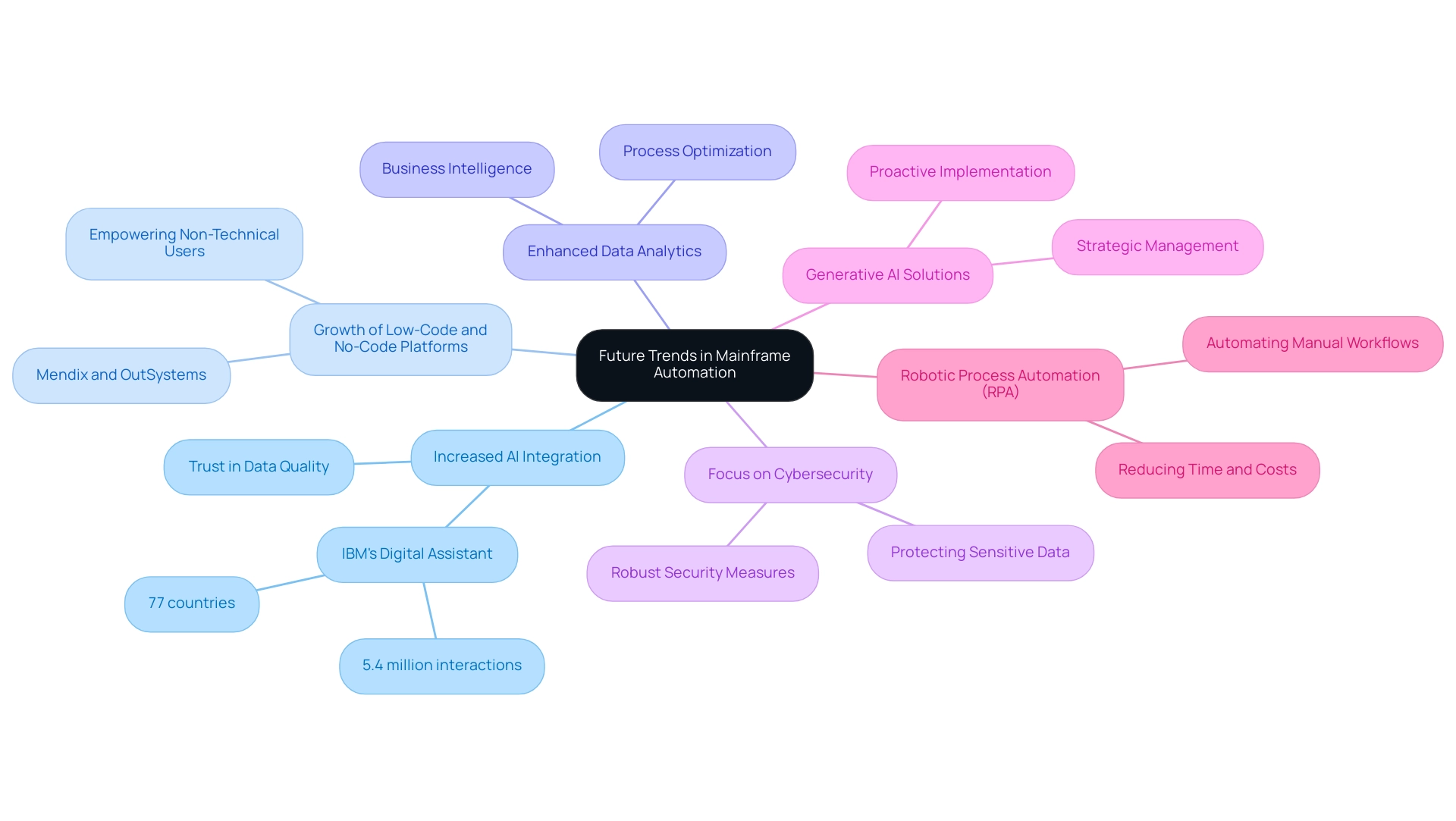
Conclusion
Mainframe automation is not just a technological upgrade; it is a strategic imperative for organizations aiming to thrive in today’s fast-paced marketplace. By leveraging tools such as Robotic Process Automation (RPA) and artificial intelligence (AI), businesses can significantly enhance operational efficiency, reduce costs, and improve accuracy across their processes. The successful implementation of these technologies can lead to remarkable outcomes, including substantial reductions in manual errors and accelerated task completion times, ultimately driving greater business value.
However, the journey toward automation is not without its challenges. Organizations must address resistance to change, integration complexities, and skill gaps while also ensuring a robust change management strategy. By proactively overcoming these hurdles, companies can cultivate a culture of innovation and resilience that embraces automation as a cornerstone of operational success.
Looking ahead, the future of mainframe automation promises exciting developments, including increased AI integration, the rise of low-code and no-code platforms, and enhanced data analytics capabilities. These trends will empower organizations to streamline their operations further and adapt to evolving market demands. By staying attuned to these advancements and strategically implementing automation solutions, companies can position themselves for sustained success and competitiveness in an ever-changing business landscape.
Embracing automation is not just about keeping pace; it is about leading the charge toward a more efficient, innovative future.

